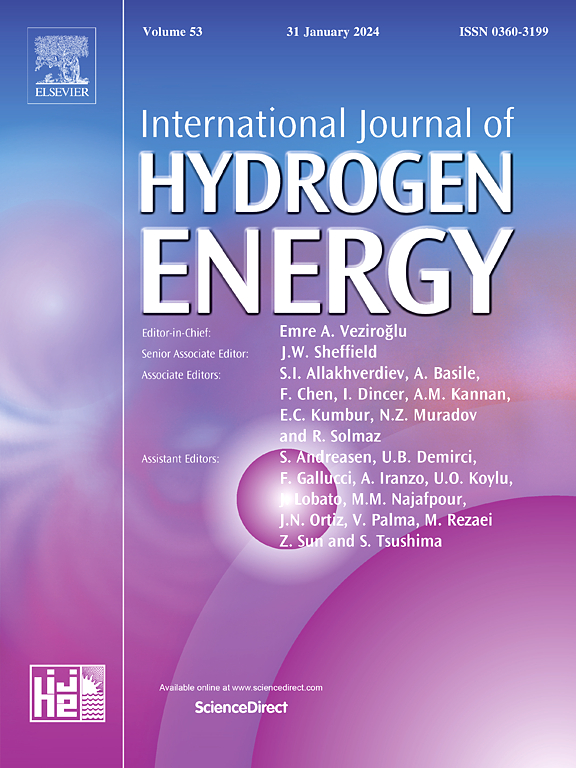二氧化钛和非金属掺杂纳米TiO2:合成及其在绿色能源生产中的应用
IF 8.1
2区 工程技术
Q1 CHEMISTRY, PHYSICAL
引用次数: 0
摘要
二氧化钛纳米粒子(TiO2 nanoparticles, NPs)由于其优异的电化学性能、稳定性、低成本和无毒性,在包括绿色能源生产在内的多个领域具有潜在的应用前景。然而,TiO2 NPs作为光催化剂的实际应用受到其宽禁带(即3.0-3.2 eV)的限制。由于非金属掺杂策略-一种潜在的和带隙工程方法来减少半导体的带隙- TiO2 NPs的激活可以通过可见光通过掺杂TiO2与非金属元素来实现。本文综述了纳米TiO2和非金属掺杂TiO2 NPs的合成方法,包括水热法、溶胶-凝胶法、离子液体辅助法、静电纺丝法、微生物介导法和植物介导法等。此外,还详细讨论了它们在绿色能源生产(即生成H2、CH4等)中的应用。此外,还阐述了TiO2和纳米掺杂TiO2 NPs光催化水裂解、光催化重整以及CO2和N2还原的机理和动力学。由于其较高的效率,锚定在TiO2上的单原子催化剂(SACs)在制氢中的应用也得到了讨论。最后,强调了二氧化钛基纳米材料在绿色能源生产中的实际应用中的主要挑战和问题。这篇综述为环境可持续性和绿色能源生产领域的研究人员提供了一个路线图,以扭转二氧化钛基纳米材料,克服其固有的缺点,阻碍其大规模的实际应用。本文章由计算机程序翻译,如有差异,请以英文原文为准。
TiO2 and non-metal doped TiO2 nanoparticles: Synthesis and applications for green energy production
TiO2 nanoparticles (NPs), due to their outstanding electrochemical properties, stability, low-cost and nontoxicity, have potential applications in multiple fields including green energy production. However, the practical applications of TiO2 NPs as photocatalysts are limited due to their wide bandgap (i.e., 3.0–3.2 eV). Thanks to the non-metal doping strategy-a potential and a bandgap engineering approach to reduce the bandgap of semiconductors-the activation of TiO2 NPs can be achieved by visible light via doping TiO2 with non-metal elements. In this review, the promising synthesis methods of TiO2 and non-metal doped TiO2 (NM-doped TiO2) NPs, including hydrothermal, sol-gel, ionic liquid assisted, electrospinning, and microbial-mediated and plant-mediated methods, have been summarized. In addition, their applications in green energy production (i.e., generation of H2, CH4 etc.) were discussed in detail. Moreover, the mechanism and kinetics of photocatalytic water splitting, photocatalytic reforming, and CO2 and N2 reduction by TiO2 and NM-doped TiO2 NPs were explained. Due to their higher efficiency, the applications of single-atom catalysts (SACs) anchored on TiO2 for H2 production have also been discussed. Finally, the major challenges and issues in practical applications of TiO2-based nanomaterials for green energy production have been underlined. This review serves as a roadmap for the researchers working in the field of environmental sustainability and green energy production to twist the TiO2-based nanomaterials to overcome their inherent shortcomings which prevent them from large-scale practical applications.
求助全文
通过发布文献求助,成功后即可免费获取论文全文。
去求助
来源期刊

International Journal of Hydrogen Energy
工程技术-环境科学
CiteScore
13.50
自引率
25.00%
发文量
3502
审稿时长
60 days
期刊介绍:
The objective of the International Journal of Hydrogen Energy is to facilitate the exchange of new ideas, technological advancements, and research findings in the field of Hydrogen Energy among scientists and engineers worldwide. This journal showcases original research, both analytical and experimental, covering various aspects of Hydrogen Energy. These include production, storage, transmission, utilization, enabling technologies, environmental impact, economic considerations, and global perspectives on hydrogen and its carriers such as NH3, CH4, alcohols, etc.
The utilization aspect encompasses various methods such as thermochemical (combustion), photochemical, electrochemical (fuel cells), and nuclear conversion of hydrogen, hydrogen isotopes, and hydrogen carriers into thermal, mechanical, and electrical energies. The applications of these energies can be found in transportation (including aerospace), industrial, commercial, and residential sectors.
 求助内容:
求助内容: 应助结果提醒方式:
应助结果提醒方式:


